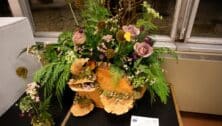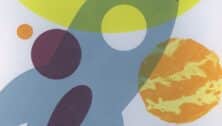“Construction Time Again” Group Art Exhibition at Bucks County Community College


The artists and architects in the exhibition, “Construction Time Again,” on view from Jan. 19 – March 8, 2024, in Hicks Art Center Gallery creatively respond to social, cultural, architectural, ecological, and environmental sustainability in urban and rural environments through their projects.
Named after the title of the 1983 studio album by Depeche Mode of the same name, the participating artists, and architects in “Construction Time Again” employ diverse materials, subjects and media to address the impacts of construction and demolition on buildings, lands and people over periods of time in numerous locales.
As the lyrics of Depeche Mode’s song, “The Landscape Is Changing” decry, “Now we’re re- arranging, There’s no use denying, Mountains and valleys, can’t you hear them sighing,” the objects and works in the exhibition challenge us to evaluate our collective responses and responsibilities to outcomes of our presence on Earth and to seek new ways of sustainable resourcefulness.
While all the artists, architects and museum as well as their objects and projects in “Construction Time Again” are very different in appearance, each are examples showing us what has happened, what is happening, and what will happen to our environment in a collective effort to help all to see how we can keep our Earth a place that is habitable for many generations to come—not just a few.
As a basis to the exhibition, seeing through filters of air, water and traceries of building sites is vital to interpreting what is constantly changing in the environments that surround us. But what are the nuances of perspective when atmosphere, distance and other phenomena are constantly mediating our vision both indoors and outside?
Gwen Kerber’s floor installation serves as a launchpad to visualize how we perceive not only the natural world, but also built environments. Using grids, color and vantage, Kerber’s “Wading; Field of Vision Looking Down at a 45 Degree Angle from About Two Feet Away” brings us closer to our bodies’ limits, depths, and confines.
Arden Bendler Browning’s AR video/painting works collide gestural, seemingly abstract paintings with buildings and landscapes that take the viewer on mesmerizing journeys through moving colors overlayed on and woven through familiar and wild sites. Like Kerber, Bendler Browning uses vision and sight as tools to convince us that the act of observing is imperative to comprehending movements of our surroundings that could be life-threatening or affirming.
With Kerber’s and Bendler Browning’s works addressing the tasks of perception acknowledging change, Diane Burko’s diptych, “Deforestation 1 and Deforestation 2” confronts the fact of the Amazon’s rapidly diminishing natural filter that prolongs life on earth head on. With the encircled word “DEFORESTATION” on one fiery panel hung next to another depicting a cropped map of South America with the Amazon outlined in the same white as the circle on the opposite panel, the viewer has no escape from being implicated as holding great responsibility to environmental cataclysm through the proliferation of fossil fuels and corporate greed.
Borrowed from the Museum for Art in Wood, Jean-François Delorme’s mixed media sculpture “Broken” is the artist’s personal narrative of his body suffering a fall and a material also breaking apart but still maintaining perfection. In the exhibition context, the upturned crutches and breaking sphere represent the Earth being barely held up in space while breaking apart—a macabre warning.
Another artist in the exhibition addressing architecture, however from a more localized sociological and historical lens, is Nicolo Gentile. Parts of his sculptures were fabricated using melted down metals from a building, now demolished, that once housed the 12th Street Gym in Philadelphia, which was vital to the gay community as a hub promoting health and well-being. Now, Gentile’s sculptures are almost all that is left as physical memories of an important community gathering spot.
Depletion of natural resources is one of the central themes in Kristen Neville Taylor’s recent body of work “End of Days.” With personal ties to glass production and installation, her father worked as a glazier, Taylor’s pate de verre’s, videos, and sculptures reveal myths and lore around the evolution of the sand mines of the New Jersey Pine Barrens that are mostly vanished except for massive lakes of blue water that appear to be natural.
The Bucks County Historic Association’s Mercer Museum generously allowed Hicks Art Center Gallery to borrow two objects that were once used to pump and to channel water: one from the earth and one from a barrel. From a curatorial perspective, it is important to include such objects in an exhibition such as this to historicize the industrialization of the extraction of natural resources, especially water.
All are welcome to the opening reception on Wednesday, January 17 from 4:30 – 7 PM at the Hicks Art Center Gallery on Bucks County Community College’s Newtown Campus (275 Swamp Road, Newtown, PA 18940).
Gallery hours are Monday through Friday 9 AM – 4 PM and Saturdays from noon – 4 PM.
For more information, visit the Hicks Art Center Gallery website and follow on Instagram @bcccartscomm.
Connect With Your Community
Subscribe for stories that matter!
"*" indicates required fields






























